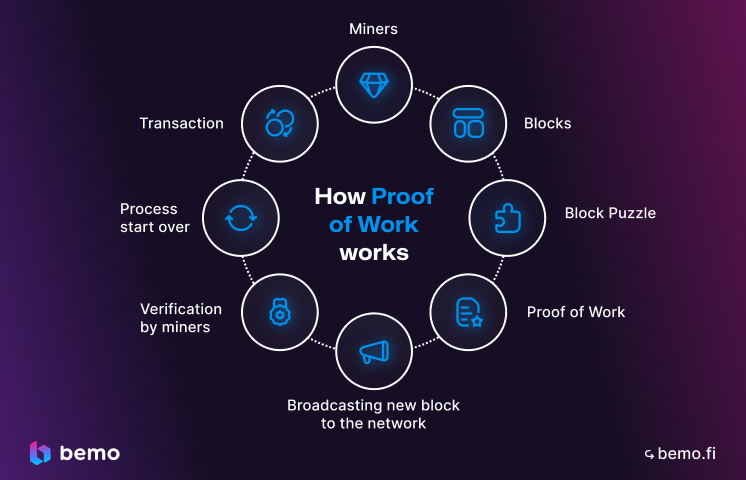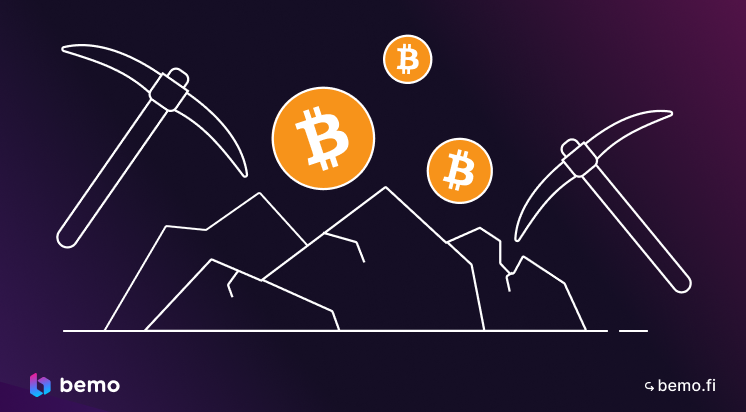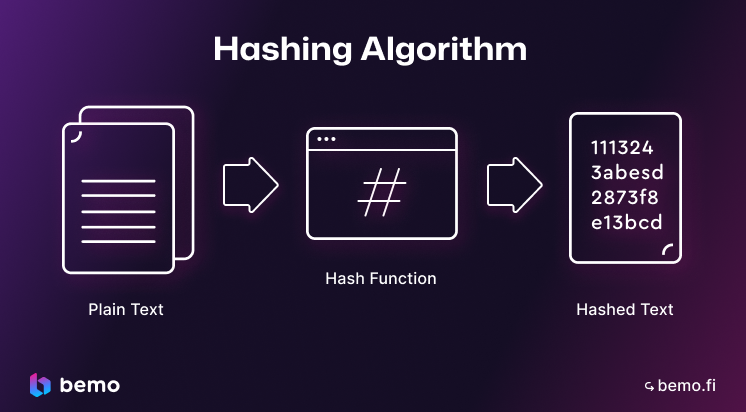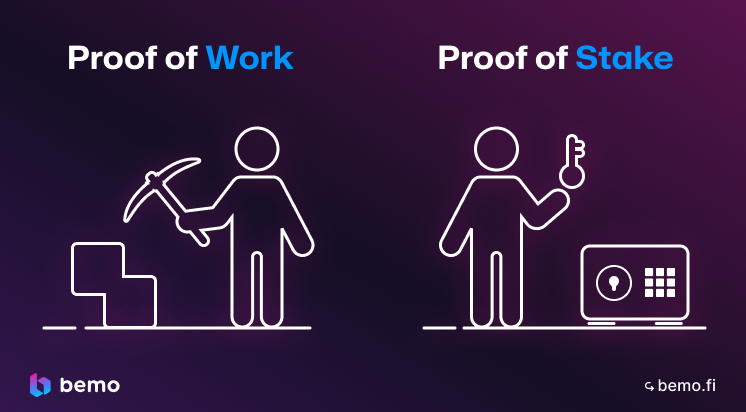Proof-of-Work (PoW) is a mechanism of consensus. How to be sure that you deserve the reward (mine some crypto)? You need to work and solve some type of puzzle.
Proof-of-Work (PoW) is one of the foundational mechanisms in blockchain and cryptocurrency. It’s a consensus algorithm that secures decentralized networks and ensures their integrity by requiring participants to solve complex computational problems. In this article, we will dive into the details of PoW, its origins, operation, examples, advantages, and challenges, while exploring its future potential and relevance.
What is Proof-of-Work in blockchain and crypto?

Key concepts and definitions
Proof-of-Work is a consensus mechanism used to validate transactions and create new blocks on a blockchain. It requires participants, called miners, to perform extensive computational work to solve mathematical puzzles. The first miner to solve the puzzle earns the right to add a new block to the blockchain and is rewarded with cryptocurrency.
Key definitions:
- Consensus Mechanism: A method to ensure all participants in a decentralized network agree on the state of the blockchain.
- Hash Function: A cryptographic algorithm that transforms data into a fixed-size output, essential for securing blockchain operations.
- Mining Reward: Compensation given to miners for validating transactions and securing the network.
- Security: The task is so difficult that a malicious actor would need immense computing power to deceive the network.
Origins and evolution of PoW
As you can imagine, bitcoin wasn't the first thing that used a proof of work mechanism. At the beginning of the WWW, PoW was first conceptualized in 1993 as a method to prevent email spam and denial-of-service attacks.
Before Bitcoin, Proof-of-Work was used in that type of projects as Hashcash (1997), RPOW (2004), DigiCash (1989), and B-Money (1998). All these “grandparents” of Bitcoin worked on PoW mechanisms and were simpler versions of modern cryptocurrency.
It gained prominence with Bitcoin, which implemented it as its core consensus mechanism in 2009. Over time, Proof-of-Work has evolved to secure various blockchain networks, inspiring alternative models like Proof-of-Stake (PoS).
How does Proof-of-Work (PoW) operate?

The role of miners
Miners are the backbone of PoW systems. They:
- Compete to solve cryptographic puzzles by utilizing computational power.
- Validate transactions to ensure they are legitimate and prevent double-spending.
- Add new blocks to the blockchain and receive rewards for their efforts.
Full node operators
Full node operators maintain the network’s integrity by:
- Verifying transactions and blocks independently.
- Storing a complete copy of the blockchain to ensure data accuracy and security.
- Broadcasting valid blocks and rejecting malicious ones.
The hashing process

First of all, the hash function is a special mathematical algorithm that converts data of any size into a unique string of fixed length. In blockchains, hashes are used to link blocks of data, secure information, and verify transaction authenticity.
Hashing is at the heart of the Proof-of-Work algorithm. Miners input transaction data and a random value (nonce) into a cryptographic hash function. The goal is to find a hash value that meets the network’s difficulty target. This process involves trial and error, requiring immense computational resources.
Examples of Proof-of-Work in Action
Bitcoin’s PoW mechanism
Bitcoin’s Proof of Work mechanism is the most recognized example. It ensures:
- Secure and decentralized transaction validation.
- Block production every 10 minutes, adjusting difficulty to maintain consistency.
- A reward-halving mechanism to control Bitcoin’s supply and encourage long-term stability.
Other PoW-based cryptocurrencies
Aside from Bitcoin, several cryptocurrencies utilize PoW, including:
- ETH, Ethereum (pre-merge): Used PoW before transitioning to PoS in 2022.
- LTC, Litecoin: Implements a modified PoW algorithm called Scrypt, designed for faster transaction times.
- XMR, Monero: Focuses on privacy while using RandomX, a PoW algorithm optimized for CPU mining.
- DOGE, Dogecoin. Even the memecoin of Elon Musk based on proof of work standards. It shares the same Scrypt algorithm as LTC and has faster block times and an accessible mining process.
Proof of Work vs. Proof of Stake

The Proof of Work (PoW) mechanism has a huge competitor in the form of Proof of Stake (PoS).
Proof-of-Work (PoW) requires participants (miners) to solve complex computational puzzles to validate transactions and secure the network, consuming significant energy and computational resources. Proof-of-Stake (PoS), on the other hand, selects validators based on the number of coins they hold and stake, making it more energy-efficient and reducing the reliance on expensive hardware.
For example, TON based on Proof-of-Stake algorithms. But we talk about it in the articles about TON and about PoS
Key differences
| Aspect | Proof of Work (PoW) | Proof of Stake (PoS) |
|---|---|---|
| Energy consumption | High | Low |
| Validator selection | Computational power (mining) | Stake ownership (coin holding) |
| Security approach | Physical resource investment | Economic stake |
Pros and cons of each model
| Pros | Cons | |
|---|---|---|
| PoW | Proven security model. Decentralized and resilient. | High energy consumption. Limited scalability. |
| PoS | Energy-efficient. Faster transaction validation. | Risk of centralization. Wealth concentration issues. |
Advantages and Disadvantages of Proof-of-Work
Security and decentralization
PoW offers robust security by requiring significant computational effort to attack the network. Its decentralized nature ensures no single entity can control the blockchain.
Energy efficiency challenges
One of PoW’s main drawbacks is its energy consumption. Mining operations require vast amounts of electricity, raising concerns about environmental sustainability.
Proof of Useful Work (PoUW)
Concept and use cases
Proof of Useful Work (PoUW) builds on PoW by redirecting computational efforts toward solving real-world problems, such as scientific research or AI model training. This concept aims to make blockchain operations more meaningful and impactful.
You might think it sounds familiar and you've seen it before. And that’s almost true. DePIN (Decentralized Physical Infrastructure Networks) share some similarities in aligning blockchain technology with real-world utility.
But they have key differences:
- Domain of use:
- PoUW focuses on computational tasks that solve global challenges, such as scientific research.
- DePIN focuses on incentivizing decentralized infrastructure through blockchain technology.
- Output:
- PoUW outputs computational results that contribute to external projects.
- DePIN builds physical infrastructure networks operated by decentralized contributors.
Potential impact on blockchain
PoUW could revolutionize blockchain by:
- Increasing societal value from mining efforts.
- Addressing criticisms of PoW’s wastefulness.
- Expanding blockchain use cases into non-financial domains.
Environmental and energy concerns
Energy Consumption
PoW’s energy demands are immense, with Bitcoin’s network alone consuming more electricity than in some countries. This consumption stems from the competitive nature of mining, where miners continuously run high-powered hardware.
Sustainability Initiatives
To address environmental concerns, initiatives such as:
- Renewable energy-powered mining operations.
- Carbon offset programs for miners.
- Research into more efficient algorithms.
Mining hotels or mining saunas – why not? You can already find a couple of these projects, which are trying to use excess heat generated by mining farms.

Special considerations and the future of PoW
Scalability Challenges
PoW networks face scalability issues due to limited transaction throughput and high fees. Layer-2 solutions and off-chain technologies aim to mitigate these challenges.
Innovations in PoW
Innovations include:
- Hybrid consensus models combining PoW and PoS.
- Development of eco-friendly PoW algorithms.
- Enhanced mining hardware for greater efficiency.
Conclusion: why Proof-of-Work still matters
Despite its challenges, Proof-of-Work remains a cornerstone of blockchain technology. Its unmatched security and decentralization make it indispensable for networks like Bitcoin. As the industry evolves, PoW’s role will likely adapt, blending traditional methods with innovative approaches to meet modern demands.








